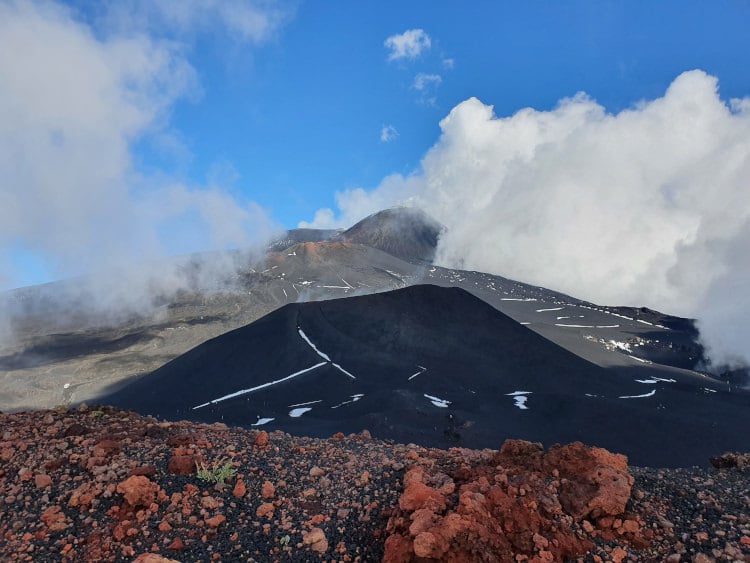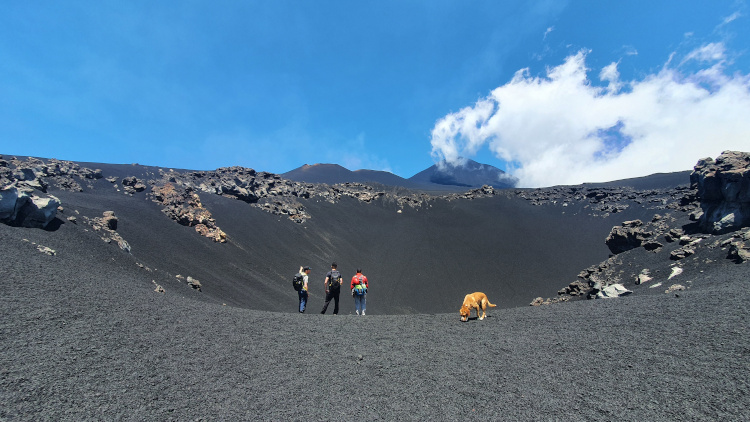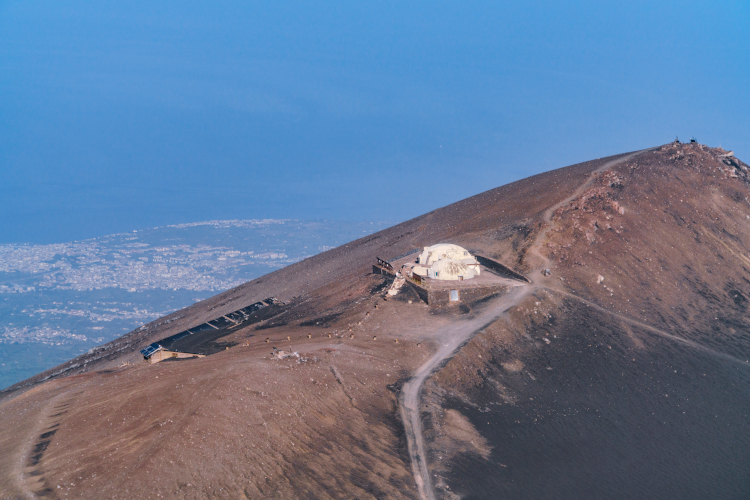Mount Etna has not only 4 main craters, but also almost 300 lateral craters. Every hill we see in the vast Etna area is an extinct lateral crater.
Lateral eruptions are so-called monogenetic eruptions, i.e. openings that are active only once and then are so firmly closed that they never erupt again. The main craters, on the other hand, are constantly “open” (connected to the magma chamber) and can erupt again and again.
The main craters have the following names:
- The central crater, which was the only main crater of Etna before 1911 and was probably formed during the eruption of 1669. In it are the (still active) vents Voragine (meaning hole in the ground, maw; formed in 1945) and Bocca Nuova (New Mouth; formed in 1968).
- Northeast crater (formed in 1911)
- Southeast crater (formed in 1971): since a measurement in July 2021, this is considered the highest point of the volcano at 3357 metres.

The central crater with Voragine and Bocca Nuova. You can only enjoy this breathtaking view of the 4 huge summit craters on our helicopter tour.
Almost each of the lateral craters also has a name. Some of them are very simple, for example two craters on the north side of Etna called Il Primo and Il Secondo (the first, the second).
But where do the Sartorius craters get their name from and why is there a crater called Laghetto (small lake)?
Craters on the south side
On our tours on the south side of Etna, we climb some lateral craters, even some that are still hot, for example the crater Montagnola (small mountain), which was formed in 1763 and is now only half a crater because the southern rim of the crater has collapsed away. We also pass the following craters on our tours and they also have interesting names.
Laghetto crater (approx. 2650 metres altitude)
Before the Laghetto crater was formed during the 2001 eruption, there was a plain in its place where the meltwater collected. A small lake formed every spring. This plain was therefore also called Piano del Lago (plain of the lake).
Officially, this crater is called Monte Escrivá. It is named after Josemaría Escrivá, the founder of Opus Dei, who was canonised in 2001, the year the crater was created.

The Laghetto crater (black) photographed from Montagnola (red). In the background, the southeast crater and at its foot the (also somewhat reddish) Barbagallo crater.
Cisternazza (pit crater)
Another crater we pass on our Etna South tour is the Cisternazza crater, a pit crater. It does not have the typical cone shape, but is a huge hole in the ground, formed by a collapse. Cisternazza means cistern, because water also collects in this pit.

Barbagallo craters (approx. 2900 metres altitude)
A little higher up are the two Barbagallo craters, which were formed during the 2002 eruption. Few people know that actually only the higher of the two craters is called Barbagallo, the lower one is called Tazieff, named after the French volcanologist Haroun Tazieff.
But everything in order: the Barbagallo crater takes its name from Vincenzo Barbagallo, a volcano guide on Etna who came from a family of volcano guides: from 1801 to 1977, fathers and sons from this family showed the volcano to the many (also famous) guests. Vincenzino Barbagallo (* 1909, died 1977) was also the curator of the volcanological observatory and was very well known in Italy as the “guardian of the craters”. He became friends with the French volcanologist Haroun Tazieff, who had become famous for his films about volcanic eruptions and later became French Secretary of State.

You can climb Barbagallo from the Torre del Filosofo (Philosopher’s Tower). Why this place at the foot of the crater is so called, we have already explained in another article (Legends about Etna).
Craters on the north side
Monte Frumento delle Concazze
The largest lateral crater is Monte Frumento delle Concazze on the north side of Etna. It is made of reddish rock (the colour is due to the oxidation of the iron contained in the lava), is about 2150 metres high and was formed about 3500 years ago. It is also one of the craters with the longest name. Frumento means grain and concazza (conca) means hollow or basin. The name derives from the fact that plants that look like grain, a kind of wild rye, grow around the crater.
Sartorius craters (approx. 1780 m)
Unique and famous is the button line of the 7 Sartorius craters. This row of 7 cones was created in 1865. It is named after Wolfgang Sartorius of Waltershausen.

But why does a crater in Sicily have a German name? Wolfgang Sartorius von Waltershausen was a German geologist and astronomer. He lived in the 19th century and spent several years of his life in Sicily exploring Etna. He measured the lava flows of Etna and published these maps in his work “Atlas of Etna”. His measurements were so accurate that they were still used until the 1980s, when people switched to satellite photography.
These craters were named in his honour.
We walk along this button line on our Etna & Alcantara and Etna & Wine adventure tours.
Pizzi Deneri (2850 m)
Not a crater, but an important testimony to the volcano’s evolutionary history: Pizzi Deneri marks the highest point of Etna’s old structure on its north-eastern side. When the old summit collapsed, the Valle del Bove was formed; the edges of the valley still give a hint of Etna’s old shape, and Pizzi Deneri, at an altitude of 2850 metres, marks the end.
The volcanological observatory of the INGV of Catania (National Institute of Geophysics and Volcanology) is located here. And up to Pizzi Deneri is the annual ultramarathon “From 0 to 3000”, which starts at the sea and ends 43 kilometres and more than 3000 metres of altitude later at Mount Etna.

Its name is one of the many examples of Sicilian dialect words used to name the craters. Deneri derives from the Sicilian word “rina”, which means volcanic sand, thus “di rina” (made of volcanic sand).
If you want to discover the craters on the north side, join us on the North Craters Tour. On this tour we discover the 2002 eruption and the huge lateral craters that were created.
Many other craters or formations have interesting names, but we’ll tell you about them another time.

